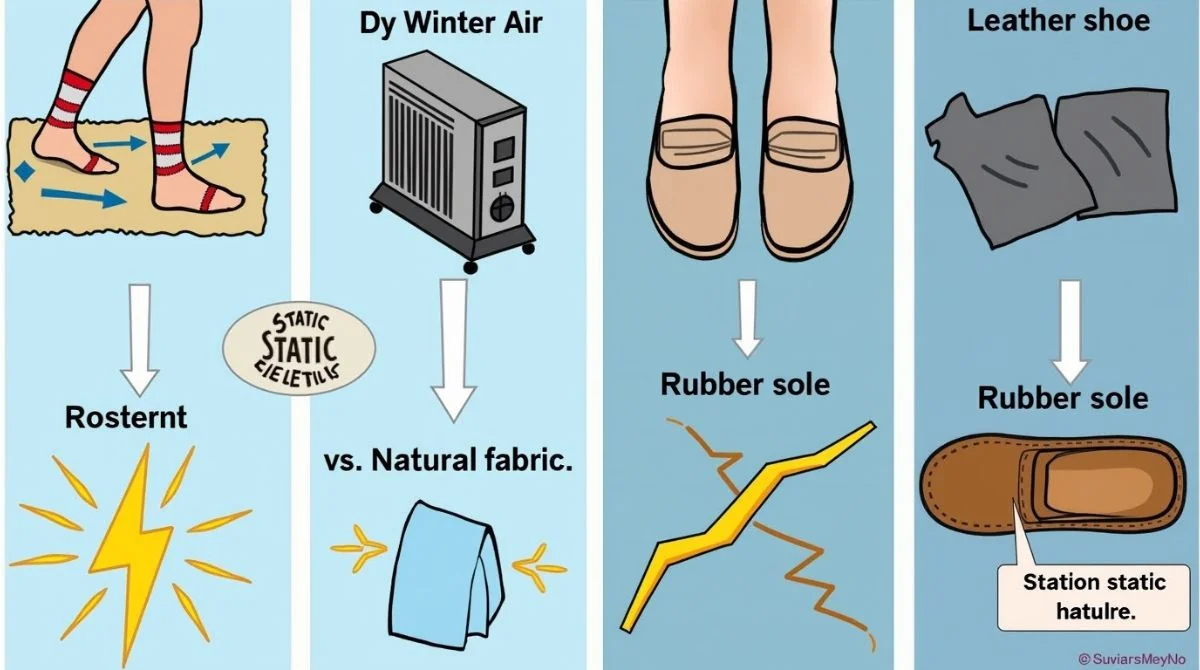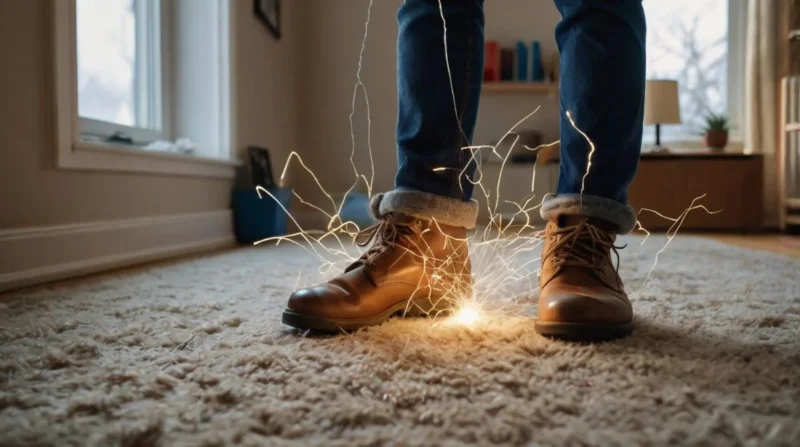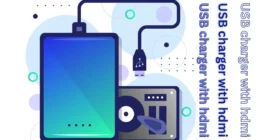Table of Contents
Have you ever shuffled across carpet and instantly felt a zap when touching a doorknob? That sudden shock is static electricity, a tiny, sudden displacement of electrons caused by an imbalance of electric charge on your body or objects around you. The good news? You can understand it and even prevent it easily with everyday solutions. This guide discusses the science behind static, why it happens more in winter, and, most importantly, how to get rid of static electricity using simple, practical tips.
What Is Static Electricity?
Static electricity is an imbalance of electric charges that builds on an object’s surface. Every atom has equal numbers of protons (positive) and electrons (negative), so it’s usually neutral. But when two surfaces rub together, like your socks on carpet or hair under a wool hat, electrons may transfer, leaving one object negatively charged and the other positively.
This imbalance stays until it finds a path to equalize, often causing that familiar “zap” of a static shock.
Why Does Static Build Up?
1. Friction Transfers Electrons.
Any rubbing motion between insulating surfaces (clothes, carpets, furniture, hair) can transfer electrons, causing static buildup. Common examples:
- Walking across a carpet in socks.
- Removing a sweater.
- Brushing hair with a plastic comb.
2. Dry Air Prevents Charge Dissipation
Static accumulates more in low-humidity environments, like during winter or in air-conditioned rooms, because dry air traps the charge instead of allowing it to disperse in moisture-rich air.
3. Materials Matter
Different materials have varying tendencies to gain or lose electrons. Synthetic fibers (polyester, nylon, fleece) build static easily, while natural fibers (cotton, wool) are less likely to hold a charge.
4. Footwear & Insulation
Rubber-soled shoes keep the charge stuck on your body because rubber doesn’t let electrons escape to the ground. Leather soles help you discharge gradually.
5. Truly Everywhere, Even Nature
Believe it or not, static electricity also powers lightning in storms and unexpected sparks in dry sand dunes or volcanic ash. In everyday settings, though, we’re usually dealing with gentle discharges.

Why Do Static Problems Spike in Winter?
Winter dryness isn’t just uncomfortable; it’s the perfect recipe for static electrification. Indoor heating dehydrates the air, so the charge remains on your body and fabrics, increasing the chance of shocks and clinging.
Additionally, wearing multiple layers adds friction, generating even more static as you move.
Is Static Electricity Dangerous?
Most of the time, the tiny shocks are harmless, just annoying. But static can cause real issues in certain settings:
- Sensitive electronics (computers, circuit boards) can be damaged by sudden discharges.
- Flammable environments (fuel stations, workshops) risk fire or explosion if a static spark ignites vapors.
How to Get Rid of Static Electricity?
Let’s put science into action; these are effective, simple ways to reduce or eliminate static electricity in your daily life.
1. Increase Humidity
Use a humidifier or place bowls of water near heaters to raise indoor humidity to about 40–60%. Moist air allows charges to flow away, neutralizing surfaces.
2. Choose Natural Fibers
Opt for cotton, wool, linen, or leather over polyester and nylon.
Natural materials don’t generate or hold onto static as much.
3. Use Anti-Static Products
- Dryer sheets in laundry reduce static cling; rub them on clothes, carpets, or hairbrushes.
- Anti-static sprays work well on furniture, curtains, and clothing.
- DIY sprays, Mix water with a bit of fabric softener or vinegar in a spray bottle.
4. Ground Yourself
Touch a grounded metal object (doorknob, radiator, metal desk, or even a light-switch panel) to discharge built-up charge.
Best practice: Use a metal key or wire hanger to make contact before skin touch.
5. Wear Better Shoes
Go leather-soled or barefoot (indoors) to help the static dissipate through your body to the ground.
6. Use Dryer Alternatives
- Wool dryer balls naturally reduce static more than regular drying.
- Add a damp towel or washcloth for the last cycle to introduce moisture.
7. Add Moisture to Skin & Hair
Dry skin holds more static; use a light lotion after showering. Let your hair “sit” to quell buildup. Spritzing hair with a bit of water or running dryer sheets gently over it also helps.
8. Use Conductive or Metal Tools
Rubbing a metal coat hanger or carbon-fiber brush helps transfer electrons away safely.
A piece of aluminum foil works, too; just rub it over your hair or clothes.
9. Let Static Die Naturally
If you’re not in a hurry, stand still; static charges slowly fade in just a few minutes.
10. Ground Electronics
For sensitive devices, use antistatic wrist straps, mats, or bags to avoid damage.
Quick Comparison Table
| Issue | What Works |
|---|---|
| Shaggy hair | Moisturize skin, humidifier, and anti-static spray. |
| Static clothes | Dryer sheets, wool balls, and natural fabrics. |
| Household surfaces | Anti-static sprays, metal grounding. |
| Electronics protection | Ground straps, antistatic bags. |
| Flammable area safety | Ground everything; avoid friction buildup. |
Conclusion
Static electricity is simple physics at work: electrons moving and staying put until they find a path to ground. Whether it zaps your finger, messes your hairstyle, or threatens electronics, the fix is straightforward: control humidity, reduce friction, and add grounding techniques. With just a few smart habits, like using a humidifier, switching materials, and touching grounded metal, you can practically eliminate those annoying zaps and static cling for good.
Related Topic: What is Electrostatic Discharge?









